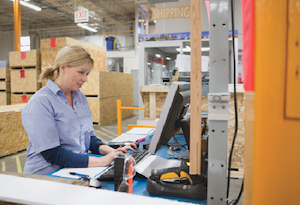Are You Reducing Risk, Or Inviting It?

A MODERN WAREHOUSE MANAGEMENT SYSTEM IS ESSENTIAL TO SUPPLY CHAIN, WORKFORCE, E-COMMERCE, AND GREEN STRATEGY
By Kim Phelan
Today’s distribution warehouse is a cost center, and in the face of economic volatility, businesses seeking to keep more cash on-hand may decide to freeze, or even shrink, budgets. Additionally, warehouses are facing talent shortages and it’s difficult to find and maintain employees. Faced with these challenges, it’s important that distributors are maximizing employee resources on tasks that can’t be automated. While a warehouse
management system may seem costly, it’s a valuable investment that can help eliminate manual processes, reduce redundancies, and increase efficiencies across the entire business, according to Abby Jenkins, product marketing manager at Oracle NetSuite.
 |
| Abby Jenkins |
And if you’re a distributor who’s not currently considering updating their WMS systems, John Carrico, vice president, product management, distribution and building supply at Epicor reminds you to consider what has happened in the industry in just the past two and a half years – namely, he said, increased uncertainty in our global supply chains, increasingly competitive labor markets and higher costs, and the expanded role that e-commerce is playing in your overall sales revenue.
“Without a modern WMS, it will be significantly more difficult to meet these new challenges and stay competitive in any market,” Carrico said.
 |
| John Carrico |
The most important Warehouse Management System (WMS) features to improve an industrial distributor’s operations are, according to Carrico:
- Process Automation and Optimization: Automated tracking using robotics, barcodes, or RFID technology, paired with advanced algorithms, minimize data entry errors and optimize picking and packing process. This results in increase staff productivity, reduced process errors and stockouts, and a better customer experience.
- Data Integration with Real Time Analytics: Getting the right information delivered in real time in a way that drives better decision-making from senior leadership to front line staff. Integrating with other systems like enterprise resource planning (ERP) and transportation management systems (TMS)
- improves cross-department coordination and ensures visibility across the entire supply chain.
- Cloud-Based Systems: Having a cloud-based system makes scaling with your business easier and less costly with reduced capital expenditures and lower maintenance and IT costs. Cloud-based systems also provide enhanced security and resilience with less system downtime.
- Multi-platform compatibility: Teams are increasingly working remote and on a wide array of devices. That being said, WMS needs to be flexible to operate where and on what device that employee is working at that time seamlessly. Even on the warehouse floor, handheld devices are becoming the norm for many operations, and systems need to be optimized for those devices and simplified so the front-line user sees the system as an asset and not an obstacle.
Bill Denbigh, vice president of product marketing at Tecsys, says automation is the coming trend in the warehouse, and the modern WMS should be an agnostic automation platform that can connect the several types of automation. The latest and greatest WMS incorporates platforms that support many different automation vendors and automation types in recognition of this.
 |
| Bill Denbigh |
Another thing to keep in mind: If you’ve ever felt incomplete without your cell phone, imagine how your team feels if they’re locked to stationary computer terminals. When considering WMS, mobile is an essential feature that can help distributors optimize warehouse efficiencies, said Jenkins. “With mobile capabilities, businesses can conduct all WMS operational processes via mobile application including receiving, storage, and fulfillment,” she said. “This helps eliminate manual recording processes and ensures timely and accurate inventory updates.”
Add Up The Benefits
 |
| Kelly Squizzero |
But there’s more that a WMS can help distributors address. Infor’s Kelly Squizzero, industry & solution strategy director, senior, says distributors’ customers now expect a B2C experience in the B2B world. This has major implications on the warehouse, she said, requiring distributors to provide accuracy, transparency, and speed. So, it is important for WMS systems to: (1) effectively manage inventory supporting multiple sales channels, (2) enable distributors to shift resources and warehouse space to support the demands of labor-intensive unit picking as e-commerce sales rise, (3) support advanced reverse logistics as returns are the new normal, and (4) optimize system performance/scalability to handle SKU proliferation growth of e-commerce.
 Plus, competition has increased – growing revenue in a competitive landscape requires differentiation through new value-add services, Squizzero notes, which have a direct impact on the warehouse. These labor-intensive services typically require additional warehousing space and staffing requirements, as well as re-architecting the typical flow of goods in the warehouse. Examples of value-add services that distributors provide impacting warehouse operations include: kitting and assembly services, maintenance and repair services, rental services, vendor managed inventory (VMI), and 3PL services.
Plus, competition has increased – growing revenue in a competitive landscape requires differentiation through new value-add services, Squizzero notes, which have a direct impact on the warehouse. These labor-intensive services typically require additional warehousing space and staffing requirements, as well as re-architecting the typical flow of goods in the warehouse. Examples of value-add services that distributors provide impacting warehouse operations include: kitting and assembly services, maintenance and repair services, rental services, vendor managed inventory (VMI), and 3PL services.
- Controlling costs and meeting customers’ demands in disruptive times require streamlining operations and improving productivity across the supply chain, and a WMS
- should help you control costs in the following ways:
- Labor management – to measure the productivity of your workforce, optimize your operation and reduce operational costs.
- Voice – hands-free connections and advanced speech-recognition technology to voice-enable order selection, replenishment, put-away, transfers, and receiving.
- Task interleaving – to combine complementary tasks to increase output and limit travel time.
- Slotting capabilities – to help maximize productivity and minimize travel time from location to location by determining the most advantageous arrangement of SKUs within a range of pick faces or slots.
Squizzero said today’s systems also enable distributors to keep up with the pace of change. Legacy technology hinders companies’ ability to support innovation, enable scalability, and take advantage of new technologies. WMS should feature: easy integration to ERP and material handling equipment (automation) through the use of APIs; voice processing across all functional areas; and embedded analytics to produce real time reports and KPIs.
Volatile Conditions Out There
Pause for a moment and consider the world outside your company. Globalization, the internet, new technologies, and demographic realities have been driving transformation in the industry for over a decade; however the last two years of pandemic and more recent geopolitical shifts have poured fuel on an already dynamic fire, says Werner Baumbach, head of strategic customer engagement, wholesale distribution, at SAP.
 |
| Werner Baumbach |
“Distributors need to find ways to compensate for a highly volatile business environment while competing for the business of ever-more demanding customers – and as labor is becoming a scarcer resource faster than many anticipated, they must achieve business success with fewer people,” he said. “Logistics also needs to be looked at more holistically. Advanced planning, contextual and digestible insights, and artificial intelligence help anticipate needs and better react to unforeseen events while optimizing resource utilization and operations. As for labor shortages, automation – both software and hardware – is a must when modernizing logistics and warehousing.”
Make It Easier on Employees
WMS providers recognize that ease of use and adaptability for the front-line software user are critical factors to consider when selecting a WMS for your business.
“It’s probably fair to say that warehouse worker, like truck driver, is dropping fast on the list of attractive jobs,” said Baumbach. “Working times and environments are tough, the jobs are often monotonous, and pay opportunities are limited. To attract talent and win back employees who left during the pandemic, we know companies have to make these jobs more attractive. But how?
“When persuading potential employees to consider a career in logistics, work models and pay play an important role,” he added. “But making the jobs themselves and the job environment interesting for a 21st-century workforce also requires an evolution in the role humans play in logistics and warehouses.”
Distributors can compete more effectively for talent, adds Carrico at Epicor, by selecting a system that is accessible for everyone on your team, which makes their workday better and ultimately will pay dividends in productivity gains and increased retention.
“Epicor is constantly working to improve the end-user experiences and make the tasks our customers do most often easier and faster. Drawing on our deep industry expertise, we are creating persona and function-specific views that remove unnecessary steps and visual clutter from their screens. We are also working to standardize user interface design (UI)/user experience (UX) across multiple Epicor platforms to reduce the need for extensive cross training and allow more flexibility in staff planning.
“Additionally, we are working to ensure that Epicor systems connect seamlessly to one another and to leading partners in the market in order to reduce the need to duplicate process across multiple systems.” Oracle’s NetSuite WMS guides users through important tasks, from receiving and storing items to picking and shipping them, in the most efficient way, says Jenkins. As items are processed in the warehouse, each transaction entered is automatically updated in the NetSuite inventory record and reported in real-time. A mobile system helps simplify this process and allows accurate, real-time inventory records.
“NetSuite Ship Central provides a mobile, user-friendly application that helps centralize information for warehouse employees,” Jenkins said. “With NetSuite Ship Central, warehouse managers can assign tasks and provide step-by-step instructions for employees such as how an order should be picked and packed. This helps minimize human error and provides an additional layer of checks and balances.”
 |
| Will Quinn |
Infor underscores the importance of unlocking the full potential of employees. Industry principal sales director Will Quinn says staffing and training warehouse employees continues to be an uphill battle for distributors. Employees are frustrated with older solutions that don’t provide easy and mobile access to information to help them do their jobs better.
Attracting, training, and retaining the right employees and ensuring their productivity requires new solutions he says, including:
- Modern UX that makes the visual display and navigation compatible with mobile phones and IPADs to facilitate fast onboarding on new employees.
- Enabling voice processing across all functional areas.
- Personalized interactive dashboards that highlight important tasks, alerts, and KPIs. A modern WMS can help to provide numerous benefits, such as increased efficiency, improved accuracy, and better visibility into operations. When evaluating systems, keep the needs of employees at the forefront of decision-making:
- Ease of use: Employees expect the same use of modern tech in their work lives as they do in their personal lives. This means a user-friendly interface and clear instructions, and functions enabled through mobile and voice (not paper).
- Training: Employees should be given adequate training on how to use the WMS, using both in-person training and online resources. Remember, training on old technology and inefficient processes is not good for anyone and can easily lead to employee frustration.
- Support: It is important that employees have access to support when they need it, whether through a help desk or via in-person assistance.
 At Tecsys, software is based upon its supply chain platform technology, Itopia, said Denbigh. “This provides a modern, responsive, scalable and consistent user experience that our customers have told us reduces onboarding and user training significantly,” he added. “In addition, the Itopia low-code/no-code platform empowers customers to redesign workflows, views and forms in the warehouse to perfectly match the specific task and experience level of the user.”
At Tecsys, software is based upon its supply chain platform technology, Itopia, said Denbigh. “This provides a modern, responsive, scalable and consistent user experience that our customers have told us reduces onboarding and user training significantly,” he added. “In addition, the Itopia low-code/no-code platform empowers customers to redesign workflows, views and forms in the warehouse to perfectly match the specific task and experience level of the user.”
Solving Distributor Challenges
Distributors have been dealing with various challenges for a long time, says Squizzero, including labor and talent shortages, supply chain challenges, quality control, efficiency, and customer service. Infor’s WMS helps distributors with all of these, she adds. Its WMS has been placed in the Gartner Magic Quadrant for several years and is an industry leader.
“The COVID pandemic, the war in Ukraine and, as always, changing customer expectations have brought on a variety of new challenges that have led many distribution companies to change the way they do business,” she said. “The movement from just-in-time to just-in-case inventory management in response to global disruptions is just one of these new challenges.
“Customers at all levels are now demanding that companies take sustainability seriously. In some cases, C-level executives’ bonuses are based on their results in this area,” she continued. “WMS capabilities to support sustainability efforts include more efficient packaging, pallet returns for reuse, and capabilities to ensure warehouse space is efficiently used to reduce the need for expansion.”
Today’s WMS also enable distributors to leverage artificial intelligence and machine learning to predict anticipated activity in the warehouse so resources can be appropriately aligned and inventory placed more efficiently – this is just one example of an opportunity, Squizzero said.
Added to the list of distributor challenges are the realities of higher costs, the increasing role of e-commerce, and lack of real-time, actionable, data, Carrico asserts. To address the myriad sources of uncertainty confronting industrial distribution, Epicor has focused investments in improving end-user experience and streamlining workflows so distributors can get more productivity out of every labor dollar.
For example, new business intelligence (BI) tools, like Epicor’s Grow, make it easier to get the right data in front of the right people to improve the customer experience and make better decision in real time, Carrico said. “Our solutions for better data integration across platforms – and up and down the supply chain – help reduce uncertainty forecasting and demand planning,” he added.
Volatile markets with highly-fluctuating supply and demand situations has, for logistics, resulted in the return of more focus on safety stocks and buffers to compensate for longer lead times and uncertain supply situations, says Baumbach. Modern supply chain solutions address these challenges from an end-to-end perspective, and with cloud-based, flexible solutions that fit a wide range of business sizes.
With SAP’s system, planning and execution are integrated and iterative, optimizing across the complete process, not just in an isolated, piecemeal fashion, he said. Warehousing requires flexible concepts to react to short term developments, including temporary network structures (pop-up warehouses, rented warehouse space, etc.) and the ability to distribute fulfillment across multiple locations based on cost, sustainability or other priorities.
Baumbach also noted that with energy costs on the rise, monitoring consumption and identifying improvement potential is no longer “just” a marketing activity but a necessity directly impacting profitability.
Denbigh at Tecsys adds that the convergence of B2C and B2B business practices and methods means that distributors are having to act like retailers and deal with seasonality, tight delivery schedules, very small orders and an expectation of personalized service. While these are not new problems, add in the need to manage supply chain disruptions with more resilient sourcing and stocking, and distributors are facing pressure on their margins unlike ever before. They are having to focus on offering real value and service differentiation to their customers rather than just the cheapest price. These services always end up creating more complexity and pressure in the warehouse with customer specific workflows, order personalization and other value- added services. Managing these requirements while remaining profitable requires a warehouse technology platform that can be continuously agile and rapidly evolve with the ever-changing needs of the warehouse.
At Oracle, a key focus is on helping distributors with their safety stock strategy and determining how extra inventory can impact cash flow and available space, Jenkins said. With NetSuite WMS, businesses receive a centralized view of inventory, supply chain functions, and financials to help improve forecast reliability and account for supply and demand fluctuations, she said. By maintaining an ongoing inventory analysis and optimization strategy, warehouses can ensure they don’t have too much backup inventory or too little of something that is selling rapidly. With a dynamic approach to stocking, warehouses can help maximize sales, minimize disruptions, and drive profits.
Her company also recognizes that warehouses are under increasing pressure to meet consumer and competitive demands for faster delivery. “While businesses must accelerate fulfillment speed, budgets in many cases, remain the same and warehouses must find ways to do more with less resources. To increase efficiency, NetSuite WMS helps eliminate manual processes across areas, including picking, packing, and shipping.”
For example, she explained, the system can help map and define zone picking strategies to help fulfill multiple orders at once and reduce redundancies. Additionally, Jenkins said, NetSuite Ship Central helps reduce costs by alerting warehouses to multiple orders traveling to the same destination or identifying the most efficient fulfillment centers and shipping routes.
Take My Advice
Baumbach at SAP offers this parting takeaway: “The game has changed (again). We have to manage around high uncertainty and unpredictability but still meet the high and growing customer expectations.
Do you want to reduce risk or invite it? Extreme agility, end-to-end visibility in the chain, automation through intelligent technologies and data-driven processes, and sustainable operations are no longer goals – they’re table stakes.
“Moreover, business will probably never run slower than today. You will have to continue to become quicker, be more efficient, handle more volume and meet more complex customer expectations at razor thin margins and achieve it with fewer people. In today’s “new not-so-normal”, we see a turn-around, away from pure low cost, just-in-time operations to focus on resilient and sustainable supply chains.
"Warehousing needs to be part of an overall supply chain strategy, using accurate insights and optimizing along the entire end-to-end process . . . [WMS helps you] combine and integrate modular solutions seamlessly, ensuring agility, resilience, and sustainability . . . [enabling] collaboration not just across your company or enterprise, but ideally with your entire ecosystem.”
Quinn at Infor added: “There are many different WMS on the market, and it is important to choose one that meets the specific needs and goals of the company. This may involve considering factors such as the size and complexity of the warehouse, the types of products being stored and shipped, and the integration needs with other systems including ERP. Other factors to consider include: (1) does the WMS provider know and work in your industry? (2) Do they provide industry-specific solutions and stand by their products?”
Denbigh at Tecsys advises: “Get a handle on your data in order to provide a true picture of where you are and your cost of doing business; then use that data to evaluate your potential ROI for an update to your current system. Older systems often force warehouses into manual processes and labor-intensive workarounds . . . When you let the data do the talking, the path forward is often a lot clearer.”












